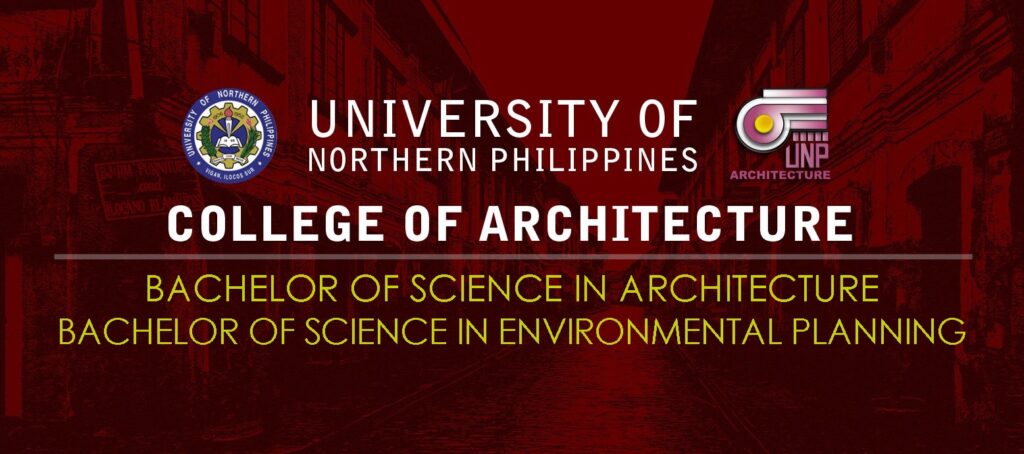About Us
Proudly located in the Heritage City of Vigan, the College of Architecture is an architectural institution committed to provide Architectural education responsive to evolving local and global demands for architects and design professionals. It provides students with comprehensive knowledge, skills and values in Architecture, with emphasis on the conservation and promotion of Filipino architectural heritage within a global context. It foregrounds the development of students’ competence and proficiency in architectural practice as provided for in Republic Act No. 9266 and its implementing rules and regulations and within the framework of democratic ideals and values.
The College of Architecture takes pride in being the first school of Architecture in Region I, established as the College of Architecture and Fine Arts (CAFA) in the University of Northern Philippines through Board Resolution No. 420, s.1971, and started operations in School Year 1972-1973. It offered the four-year degree courses in Bachelor of Science in Architecture (BS Arch) and Bachelor of Fine Arts (BFA) and the two-year Associate in Architectural Drafting (AAD) and Associate in Commercial Arts (ACA) with Mr. Arturo Rabara as Head. CAFA implemented the five-year BS Architecture curriculum in School Year 1979-1980. School Year 1980-1981 saw the Architecture program being offered under a separate Institute of Architecture with Ar. Gaudencio A. Retuta as pioneer Director until his retirement in May 1999.
Ar. Fatima Nicetas A. Rabang-Alonzo was designated new Director of the Institute of Architecture on July 1, 1999. In School Year 1999-2000, the Institute implemented a revised five-year Architecture curriculum of the Ladder-type concept that granted a Certificate in Building Technology (CBT) in third year, Certificate in Architectural Interiors (CAI) in fourth year, and the degree of BS Architecture upon program completion. The two-year AAD, later replaced by the three-year CBT, was abolished.
On July 1, 2006, the Institute was converted into a College of Architecture with Ar. Alonzo as the first Dean. In School Year 2007-2008, the College implemented anew another five-year Ladder-type curriculum in compliance with Commission on Higher Education (CHED) Memorandum Order No. 61, s. 2006, granting a Certificate in Drafting Technology (CDT) in the second year, Certificate in Building Technology and Utilities (CBTU) in the fourth year, first semester; Certificate in Computer-Aided Drafting and Design (CCADD) in fourth year, second semester; and the degree of BS Architecture upon program completion. The College also offered in the same school year the terminal programs of the one-year Certificate in Landscape Gardening (CLG) and two-year Certificate in Landscape Design (CLD); however, these certificate programs were put to freeze in School Year 2013-2014 due to small number of enrollees.
In response to the country’s shift to the K to 12 curriculum, the College started the implementation of the newest five-year Ladder-type Architecture curriculum in School Year 2018-2019 designed to cater to new Senior High School graduates as provided for in CHED Memorandum Order No. 61, s. 2017 that grants a Certificate in Drafting Technology (CDT) in second year, Certificate in Computer-Aided Drafting and Design (CCADD) in third year, Certificate in Building Technology and Utilities (CBTU) in fourth year, and the degree of BS Architecture upon program completion.
The College of Architecture is the proud home of six topnotchers in the Architect’s Licensure Examinations: namely: Benjamin D. Domenden, Jr., 16th place, 1991; Jimmy B. Adres, 6th place, 1994; Benedict A. Rabang, 7th place, 1995; Lindon A. Fontejon, 4th place, 2013; Gerald A. Abalos, 10th place, 2014 and Dan Maurice Totaan, 1st Place, 2015 Architect’s Special Professional Licensure Examination-Middle East (SPLE-ME).
Armed with the brand of education and training from the College of Architecture and coupled with innate traits of patience and diligence, our architects and design professionals strive to attain desirable niches in various fields of architectural practice and related design practices both in private and government sectors in the country and abroad.
The College of Architecture takes pride in being the first school of Architecture in Region I, established as the College of Architecture and Fine Arts (CAFA) in the University of Northern Philippines through Board Resolution No. 420, s.1971, and started operations in School Year 1972-1973. It offered the four-year degree courses in Bachelor of Science in Architecture (BS Arch) and Bachelor of Fine Arts (BFA) and the two-year Associate in Architectural Drafting (AAD) and Associate in Commercial Arts (ACA) with Mr. Arturo Rabara as Head. CAFA implemented the five-year BS Architecture curriculum in School Year 1979-1980. School Year 1980-1981 saw the Architecture program being offered under a separate Institute of Architecture with Ar. Gaudencio A. Retuta as pioneer Director until his retirement in May 1999.
Ar. Fatima Nicetas A. Rabang-Alonzo was designated new Director of the Institute of Architecture on July 1, 1999. In School Year 1999-2000, the Institute implemented a revised five-year Architecture curriculum of the Ladder-type concept that granted a Certificate in Building Technology (CBT) in third year, Certificate in Architectural Interiors (CAI) in fourth year, and the degree of BS Architecture upon program completion. The two-year AAD, later replaced by the three-year CBT, was abolished.
On July 1, 2006, the Institute was converted into a College of Architecture with Ar. Alonzo as the first Dean. In School Year 2007-2008, the College implemented anew another five-year Ladder-type curriculum in compliance with Commission on Higher Education (CHED) Memorandum Order No. 61, s. 2006, granting a Certificate in Drafting Technology (CDT) in the second year, Certificate in Building Technology and Utilities (CBTU) in the fourth year, first semester; Certificate in Computer-Aided Drafting and Design (CCADD) in fourth year, second semester; and the degree of BS Architecture upon program completion. The College also offered in the same school year the terminal programs of the one-year Certificate in Landscape Gardening (CLG) and two-year Certificate in Landscape Design (CLD); however, these certificate programs were put to freeze in School Year 2013-2014 due to small number of enrollees.
In response to the country’s shift to the K to 12 curriculum, the College started the implementation of the newest five-year Ladder-type Architecture curriculum in School Year 2018-2019 designed to cater to new Senior High School graduates as provided for in CHED Memorandum Order No. 61, s. 2017 that grants a Certificate in Drafting Technology (CDT) in second year, Certificate in Computer-Aided Drafting and Design (CCADD) in third year, Certificate in Building Technology and Utilities (CBTU) in fourth year, and the degree of BS Architecture upon program completion.
The College of Architecture is the proud home of six topnotchers in the Architect’s Licensure Examinations: namely: Benjamin D. Domenden, Jr., 16th place, 1991; Jimmy B. Adres, 6th place, 1994; Benedict A. Rabang, 7th place, 1995; Lindon A. Fontejon, 4th place, 2013; Gerald A. Abalos, 10th place, 2014 and Dan Maurice Totaan, 1st Place, 2015 Architect’s Special Professional Licensure Examination-Middle East (SPLE-ME).
Armed with the brand of education and training from the College of Architecture and coupled with innate traits of patience and diligence, our architects and design professionals strive to attain desirable niches in various fields of architectural practice and related design practices both in private and government sectors in the country and abroad.





Goal
The College is designed to deliver quality education and training of future architects to become environment and culture-sensitive, socially responsive, morally strong, and proudly competitive in the world trade of professional technical services.
Objectives
The College of Architecture aims to become a distinguished institution in:
Instruction in the art and science of designing and constructing the built environment, and conserving and managing heritage structures and their sites;
Research actions on the built environment, technology, materials, and heritage conservation and management; and
Extension and Community Engagement programs along building technology, arts and heritage conservation, and environmental management.
History
The College of Architecture takes pride in being the first school of Architecture in Region I, established as the College of Architecture and Fine Arts (CAFA) in the University of Northern Philippines in the Heritage City of Vigan through Board Resolution No. 420, s.1971. It started operations in School Year 1972-1973. It offered the four-year degree programs in Bachelor of Science in Architecture (BS Arch) and Bachelor of Fine Arts (BFA) and the two-year Associate in Architectural Drafting (AAD) and Associate in Commercial Arts (ACA) with Mr. Arturo Rabara as Head. CAFA implemented the new five-year BS Architecture curriculum in School Year 1979-1980. School Year 1980-1981 saw the Architecture program being offered under a separate Institute of Architecture with Ar. Gaudencio A. Retuta as pioneer Director until his retirement in May 1999.
Ar. Fatima Nicetas A. Rabang-Alonzo was designated the new Director of the Institute of Architecture on July 1, 1999. In School Year 1999-2000, the Institute implemented a revised five-year Architecture curriculum of the ladder-type concept that granted a Certificate in Building Technology (CBT) in the third year, Certificate in Architectural Interiors (CAI) in the fourth year, and Diploma in BS Architecture upon program completion. The two-year AAD, later replaced by the three-year CBT, was abolished.
On July 1, 2006, the Institute was converted into a College of Architecture with Ar. Alonzo as the first dean. In AY 2007-2008, the College implemented anew another five-year ladder-type curriculum in compliance with Commission on Higher Education (CHED) Memorandum Order No. 61, s. 2006 granting a Certificate in Drafting Technology (CDT) in the second year, Certificate in Building Technology and Utilities (CBTU) in the fourth year, first semester; Certificate in Computer-Aided Drafting and Design (CCADD) in the fourth Year, second semester; and diploma in BS Architecture upon course completion. The College also offered in the same school year the terminal programs of the one-year Certificate in Landscape Gardening (CLG) and two-year Certificate in Landscape Design (CLD); however, these certificate programs were put to freeze in AY 2013-2014 due to small number of enrollees.
In response to the country’s shift to the K to 12 curriculum, the College started the implementation of the newest five-year ladder-type Architecture curriculum in AY 2018-2019 designed to cater to new Senior High School graduates as provided for in CHED Memorandum Order No. 61, s. 2017 that grants a Certificate in Drafting Technology (CDT) in the second year, Certificate in Computer-Aided Drafting and Design (CCADD) in the third Year, Certificate in Building Technology and Utilities (CBTU) in the fourth year, and the BS Architecture degree upon program completion.
Ar. Fatima Nicetas A. Rabang-Alonzo was designated the new Director of the Institute of Architecture on July 1, 1999. In School Year 1999-2000, the Institute implemented a revised five-year Architecture curriculum of the ladder-type concept that granted a Certificate in Building Technology (CBT) in the third year, Certificate in Architectural Interiors (CAI) in the fourth year, and Diploma in BS Architecture upon program completion. The two-year AAD, later replaced by the three-year CBT, was abolished.
On July 1, 2006, the Institute was converted into a College of Architecture with Ar. Alonzo as the first dean. In AY 2007-2008, the College implemented anew another five-year ladder-type curriculum in compliance with Commission on Higher Education (CHED) Memorandum Order No. 61, s. 2006 granting a Certificate in Drafting Technology (CDT) in the second year, Certificate in Building Technology and Utilities (CBTU) in the fourth year, first semester; Certificate in Computer-Aided Drafting and Design (CCADD) in the fourth Year, second semester; and diploma in BS Architecture upon course completion. The College also offered in the same school year the terminal programs of the one-year Certificate in Landscape Gardening (CLG) and two-year Certificate in Landscape Design (CLD); however, these certificate programs were put to freeze in AY 2013-2014 due to small number of enrollees.
In response to the country’s shift to the K to 12 curriculum, the College started the implementation of the newest five-year ladder-type Architecture curriculum in AY 2018-2019 designed to cater to new Senior High School graduates as provided for in CHED Memorandum Order No. 61, s. 2017 that grants a Certificate in Drafting Technology (CDT) in the second year, Certificate in Computer-Aided Drafting and Design (CCADD) in the third Year, Certificate in Building Technology and Utilities (CBTU) in the fourth year, and the BS Architecture degree upon program completion.
Our Extension Services
The general extension program of the College of Business Administration and Accountancy (CBAA) stems and cascades from the University Extension Program.
Dubbed as “BUSINESS in the Communities,” it is a configuration of resources and positioning of the College as a potential partner in developing the communities. “Basic and Unperturbed Simulation, Integration, and Nurturing of Essential Support System (BUSINESS) in the Communities” captures the essential areas and key extension programs provided by the different programs of CBAA in emancipating the communities from poverty and empowering them in order to cushion the impact of poverty and clear the way for the families in the countryside in their efforts and sending their children to the school as they struggle to address their daily basic needs in their community.
“BUSINESS in the Communities” aims to a) provide livelihood trainings specially among the adopted barangays of the college; b) empower the communities by organizing them as business entities; c) equip and enhance the technical skills of the stakeholders (specially the parents) along the various aspects and fields of business; d) hone the leadership potentials of the stakeholders in order to create an orderly and peaceful communities driven by a desire for progress; e) provide logistical assistance to the beneficiaries; and f) source out resources through dynamic linkages for the effective and efficient implementation of the Extension Programs.
It is along these objectives, the programs under the BUSINESS in Communities are categorized into four:
Livelihood Training. This program aims to provide trainings on potential livelihood
Undertakings which are meant to provide opportunities to the adopted communities to earn for their living. Among these trainings are embotido and skinless longganisa making, hair science, and cosmetology.
Community and Business Organizing. This program aims to concretize the trainings provided by organizing the communities and assist them in forming business. Among the activities under this program are cooperative formation and organization and micro business formation.
Technical Skills Enhancement. This program aims to provide trainings on the various skills and competencies developed in the different programs offered by the college. Among such trainings are training-workshop along management, entrepreneurship, cooperative management, financial management, accounting, and other allied fields of business; financial statement preparation; and financial statement analysis and consultancy services.
Leadership Capability Training. This program aims to develop the leadership potentials and equip the various stakeholders in the adopted communities with the fundamentals of leadership, and the qualities of being in the frontline. Among the activities under this program are leadership training, participatory leadership and development, and social responsibility training.
Logistical Support. The program aims to augment the logistical needs of the beneficiaries of extension projects by providing them the necessary equipment and materials that they need in the use of their acquired skills in the Extension Activities and Projects.
Extension Resource Generation. This program aims to establish linkages with various individuals and institutions for the effective and efficient implementation of extension activities. These resources include both the human and non-human. The human resources are meant to augment the expertise available in the college. Experts in various fields who are not part of the institutional pool of the College. The non-human resources are meant to assist the beneficiaries in carrying out and executing the skills that they learned from the extension activities. These non-human resources may include: baking tools and equipment, oven gas stove, kitchen facilities, etc.
The College of Business Administration and Accountancy through its CBAA Extension Unit is responsive to the needs of the community towards sustainable socio-economic development. Its mission is to undertake extension programs and activities that promote the development of community-based business enterprises and cooperatives and enhance the entrepreneurs’ managerial competencies through consultancy services along financial, production, marketing, and human resource management and other allied areas. Likewise, it endeavors to strengthen attitudinal transformation towards greater productivity. In this manner, the clientele can achieve economic viability and competitive advantage.
OFFICE OF THE PRESIDENT
-
University of Northern Philippines
3rd Floor- Admin Building, Tamag, Vigan, Ilocos Sur - (077) 644-2261
- op@unp.edu.ph
Registrar's Office
- registrar@unp.edu.ph
- UNP Registrar's Office
Admission Services
- admissionservices@unp.edu.ph
- UNP Admission Services
Public Information Office
- pioffice@unp.edu.ph
- University of Northern Philippines
Guidance and Counseling Services
- guidance@unp.edu.ph
- University of Northern Philippines
